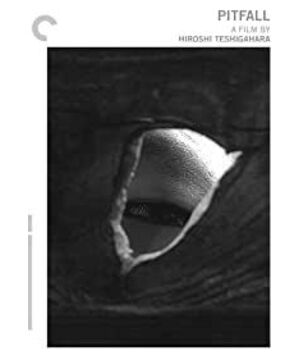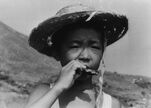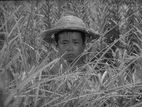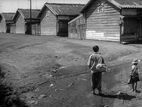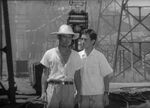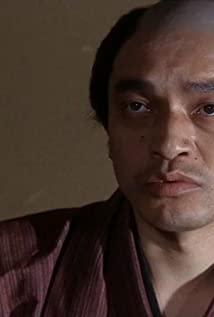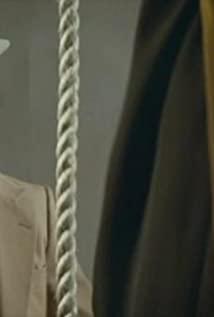"Trap" tells the story of a fugitive who escaped from a mine to a private mine with a young silent son, and then escaped to another mine, and was killed on the way to another mine arranged by his boss. series of murders.
The fugitive came to the "ghost village" with his son who had never spoken before at 7:00 in the morning. The "ghost village" was originally the residence of the miners of the mine, but it became a "ghost village" after the mine was abandoned for a long time. Because the map on the top of the fugitive's hand was not clear, he asked the only living resident in the "ghost village" - the female owner of the candy shop who was single, lonely, and waiting for the postman to deliver the letter. The director gave the single woman a "creepy" appearance in close-up: the woman squatted inside the house and used chopsticks dipped in water to clear the ants from the pastry box. Of course, this woman has no beauty, she is strong, sweaty, and has no charm.
Next, the fugitive was busy on the road and forgot to take care of his son. When he walked to a rare place, he was followed by a man in white clothes and white gloves. There is no suspense that the man in white clothes killed the fugitive with a knife, and this process Just happened to be seen by a woman. So at the same time, the camera cuts, and the silent son is playing with the frog, tearing off the frog's skin without losing any emotion. When the child finds the father, who is dead, the camera cuts to the skinned frog as the bait, and a shrimp is holding it aloft.
The man in white found the woman, left money and threats, and the woman reported the case according to the man's instructions.
The police, forensic doctors, and reporters arrived. According to the known clues, the reporter found the so-called fugitive-Otsuka who looked very similar. Otsuka was frightened and kept claiming that this was a "trap". Fake confession, Fukuyama is the murderer), thinking that someone framed him and Toyama, and agreed with Fukuyama to personally question the woman. When Otsuka arrived, the woman was strangled to death by the man in white clothes, and Fukuyama came immediately and saw Otsuka and the dead woman, thinking that Otsuka was the murderer of the whole case, and ignored Otsuka's defense. In the end, Fukuyama (the man in white explained the woman's false confession as follows: a miner-like man with a white spot on the upper part of his right ear killed the fugitive with a knife, and then threw the knife into the water) "unfortunately" found a knife in the water and used the knife He stabbed Otsuka, and Otsuka drowned Fukuyama because of his bloodshed. Shot cut: The headband that Fukuyama once wore with the word "Unity" fell into the mixed water.
Finally, the man in white appeared again, looked at his watch, and the time showed 5:15 pm.
Looking at this murder incident, the man in white only killed the fugitive and the woman. He lured Otsuka and Fukuyama to the "ghost village" with the death of the fugitive. This was carefully planned, so the man in white said "very accurate" and left.
It is quite interesting that Hiroshi Kawahara and Akira Kurosawa both introduced "ghost" roles when dealing with similar murder cases. After the fugitive and the woman died, their ghosts witnessed the part of things, but the director did not give "ghosts" omniscience. In the film, the "ghost" exists as an immortal "person" at best. They bear the audience's viewing expectations and want to find out the whole murder incident, but the ghost at this time is so weak. , no one can see them, and even if they know the partial truth, their voices cannot be heard. Even more ironically, because the fugitive did not have enough to eat before his death, his ghost would have to endure hunger forever.
In connection with what the fugitive said to his companions in the film, if he could do it all over again, he would rather be a devil, because only the devil can exist in hell. But now he's a complete ghost and still can't escape starvation, let alone the cause of his death. Isn't this the best metaphor for people who can't enjoy their right to life, even after death?
The entire murder case took less than 10 hours. The director used a lot of panoramas, large panoramas and long-term perspectives to narrate in chronological order. No background music was used in the murder environment. In the process of detecting the incident, flashbacks, By flashing before and other techniques, he simply and calmly narrated a confusing and gripping murder case, and his narrative ability is really brilliant.
When the reporter interviewed Otsuka, we seemed to be able to see the shadow of Citizen Kane. In addition to the same type of character as a reporter, in the pictures we could see, the director also tried to put the reporter outside the frame. , or with its back to us. (Actually, when I watched Citizen Kane for the first time, I didn’t understand why the reporters turned their backs to us, and then I learned that the director used this to avoid making the audience think that the reporter is the protagonist.) Before the
film, the little boy returned to The candy house, after taking as much candy as possible, tried to run out of the "ghost village". When he found that the "ghost village" was like a maze with no way out, he left tears that he did not shed even when his father died, which seemed to confirm what Heidegger said. It is said that once a person leaves, he can never go back. Of course, the little boy's inability to go back is not only because he can't find a way to leave, not only because he has lost his father and the mobile home that his father gave him as much as possible, but also because he is useless and at a loss. And his father was a fugitive.
In the film, the little boy has always played the role of this indifferent viewer. He has no love, but he has the heart to steal, and he has the innate voyeurism of human beings (watched the whole process of a woman having sex with a lecherous police officer), I can't see any hope in this child. The director has given us a hopeless stroke for the so-called "future". Perhaps human beings themselves are hopeless.
Don't try to figure out what the real purpose of the murderer is, because that itself is a trap given by the director.
What puzzled me was that the fugitive's son was walking on the street and saw the man in white and avoided it, as if he had seen it before. Let's just interpret it as the human fear of danger.
View more about Pitfall reviews


